The Urban Heat Island Effect in the City of Valencia: A Case Study for Hot Summer Days
Abstract
:1. Introduction
2. Materials and Methods
2.1. Study Area
2.2. Climatological Data
2.3. Remote-Sensing Data
2.4. NDVI
2.5. Discomfort Index
3. Results
3.1. The Long-Term Estimation of Nighttime UHI and Tropical Nights
3.2. Case Study of the Evolution of sUHI
3.3. Comparison of AT and LST
3.4. The Discomfort Index
4. Discussion
5. Conclusions
Acknowledgments
Author Contributions
Conflicts of Interest
Appendix A
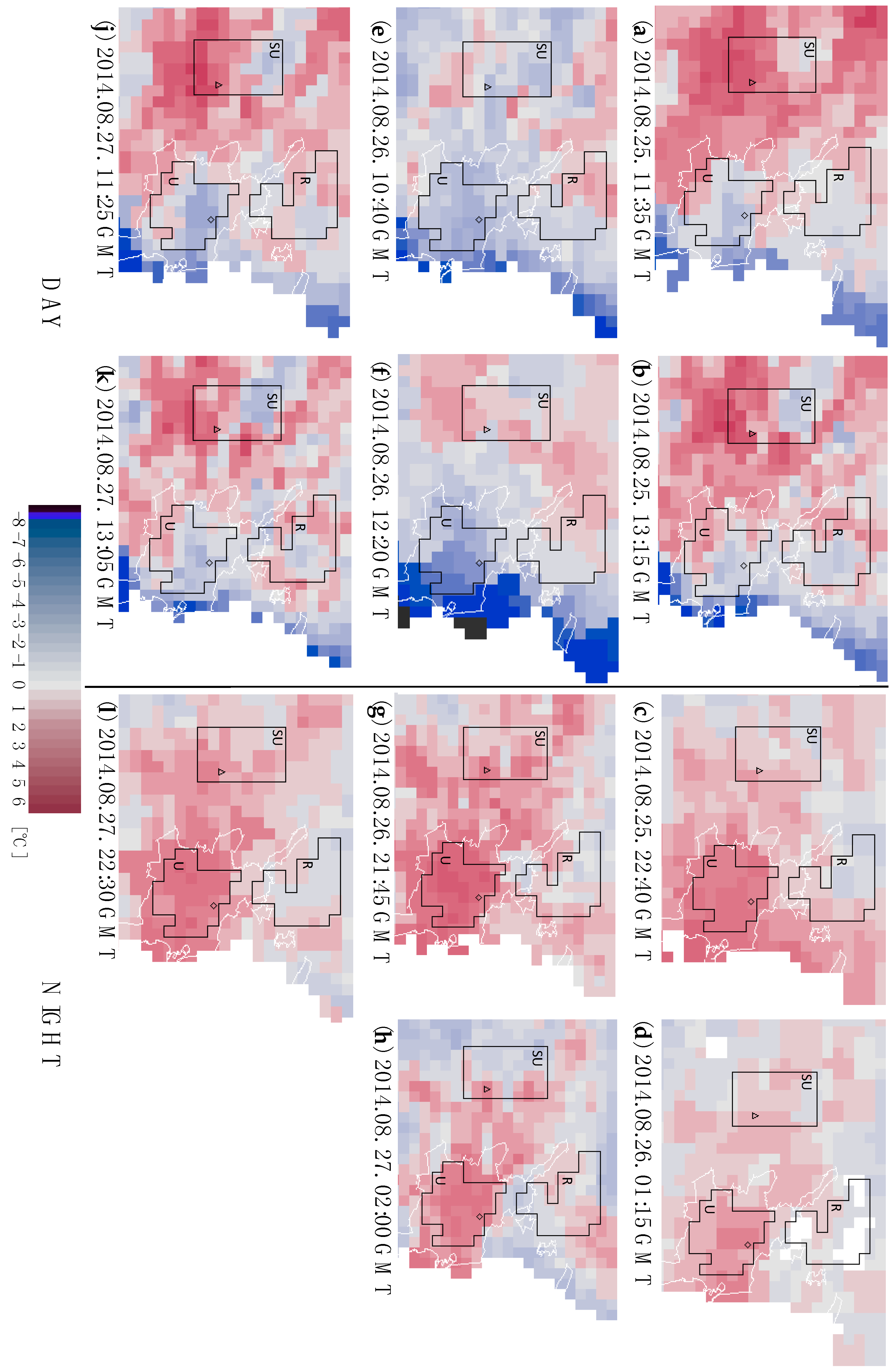
References
- Stern, N. Stern Review: The Economics of Climate Change. Available online: http://mudancasclimaticas.cptec.inpe.br/~rmclima/pdfs/destaques/sternreview_report_complete.pdf (accessed on 12 February 2017).
- Oke, T.R. The energetic basis of the urban heat island. Q. J. R. Meteorol. Soc. 1982, 108, 1–24. [Google Scholar] [CrossRef]
- Arnfield, A.J. Two decades of urban climate research: A review of turbulence, exchanges of energy and water, and the urban heat island. Int. J. Climatol. 2003, 23, 1–26. [Google Scholar] [CrossRef]
- Lindén, J.; Grimmond, C.S.B.; Esper, J. Urban warming in villages. Adv. Sci. Res. 2015, 12, 157–162. [Google Scholar] [CrossRef]
- Rosenzweig, C.; Solecki, W.D.; Hammer, S.A.; Mehrotra, S. Climate Change and CitiesFirst Assessment Report of theUrban Climate Change Research Network. Available online: http://uccrn.org/files/2015/01/ARC3-Frontmatter-Final.pdf (accessed on 12 February 2017).
- Stocker, T.F.; Qin, D.; Plattner, G.-K.; Tignor, M.; Allen, S.K.; Boschung, J.; Nauels, A.; Xia, Y.; Bex, V.; Midgley, P.M. (Eds.) Climate Change 2013: The Physical Science Basis; Contribution of Working Group I to the Fifth Assessment Report of the Intergovernmental Panel on Climate Change; Cambridge University Press: Cambridge, UK; New York, NY, USA, 2013.
- IPCC Special Report on Managing the Risks of Extreme Events and Disasters to Advance Climate Change Adaptation. Available online: https://www.ipcc.ch/news_and_events/docs/srex/SREX_slide_deck.pdf (accessed on 12 February 2017).
- Tomlinson, C.J.; Chapman, L.; Thornes, J.E.; Baker, C.J. Including the urban heat island in spatial heat health risk assessment strategies: A case study for Birmingham, UK. Int. J. Health Geogr. 2011, 10, 42. [Google Scholar] [CrossRef] [PubMed] [Green Version]
- Buscail, C.; Upegui, E.; Viel, J.-F. Mapping heatwave health risk at the community level for public health action. Int. J. Health Geogr. 2012, 11, 38. [Google Scholar] [CrossRef] [PubMed] [Green Version]
- Dong, W.; Liu, Z.; Zhang, L.; Tang, Q.; Liao, H.; Li, X. Assessing heat health risk for sustainability in Beijing’s urban heat island. Sustainability 2014, 6, 7334–7357. [Google Scholar] [CrossRef]
- Adegoke, J.; Wright, C.Y. Preface—Vulnerability of Human Health to Climate. Clim. Vulnerability 2013, 1, 1–2. [Google Scholar]
- Nastos, P.T.; Matzarakis, A. The effect of air temperature and human thermal indices on mortality in Athens, Greece. Theor. Appl. Climatol. 2012, 108, 591–599. [Google Scholar] [CrossRef]
- Vineis, P. Climate change and the diversity of its health effects. Int. J. Public Health 2010, 55, 81–82. [Google Scholar] [CrossRef] [PubMed]
- Zander, K.K.; Botzen, W.J.W.; Oppermann, E.; Kjellstrom, T.; Garnett, S.T. Heat stress causes substantial labour productivity loss in Australia. Nat. Clim. Chang. 2015, 5, 647–651. [Google Scholar] [CrossRef]
- Kennedy, C.; Pincetl, S.; Bunje, P. The study of urban metabolism and its applications to urban planning and design. Environ. Pollut. 2011, 159, 1965–1973. [Google Scholar] [CrossRef] [PubMed]
- Van Timmeren, A. The Concept of the Urban Metabolism (UM). In ReciproCities. A Dynamic Equilibrium; TU Delft: Delft, The Netherlands, 2014. [Google Scholar]
- Kenney, W.L.; DeGroot, D.W.; Alexander Holowatz, L. Extremes of human heat tolerance: Life at the precipice of thermoregulatory failure. J. Therm. Biol. 2004, 29, 479–485. [Google Scholar] [CrossRef]
- Lin, Y.; Yang, L.; Zheng, W.; Ren, Y. Study on Human Physiological Adaptation of Thermal Comfort under Building Environment. Procedia Eng. 2015, 121, 1780–1787. [Google Scholar] [CrossRef]
- Blumberg, G. Assessing the Potential Impact of Heat Waves in Cities: Implications for Hazard Preparation and Planning. Procedia Econ. Financ. 2014, 18, 727–735. [Google Scholar] [CrossRef]
- European Environment Agency. Urban Adaptation to Climate Change in Europe; European Environment Agency: Copenhagen, Denmark, 2012. [Google Scholar]
- Andersson-Sköld, Y.; Thorsson, S.; Rayner, D.; Lindberg, F.; Janhäll, S.; Jonsson, A.; Moback, U.; Bergman, R.; Granberg, M. An integrated method for assessing climate-related risks and adaptation alternatives in urban areas. Clim. Risk Manag. 2015, 7, 31–50. [Google Scholar] [CrossRef]
- Hart, M.A.; Sailor, D.J. Quantifying the influence of land-use and surface characteristics on spatial variability in the urban heat island. Theor. Appl. Climatol. 2009, 95, 397–406. [Google Scholar] [CrossRef]
- Eliasson, I. The use of climate knowledge in urban planning. Landsc. Urban Plan. 2000, 48, 31–44. [Google Scholar] [CrossRef]
- Stewart, I.D.; Oke, T.R. Local climate zones for urban temperature studies. Bull. Am. Meteorol. Soc. 2012, 93, 1879–1900. [Google Scholar] [CrossRef]
- Mendelsohn, R.; Kurukulasuriya, P.; Basist, A.; Kogan, F.; Williams, C. Climate analysis with satellite versus weather station data. Clim. Chang. 2007, 81, 71–83. [Google Scholar] [CrossRef]
- Taha, H. Urban climates and heat islands: Albedo, evapotranspiration, and anthropogenic heat. Energy Build. 1997, 25, 99–103. [Google Scholar] [CrossRef]
- Watkins, R.; Littlefair, P.; Kolokotroni, M.; Palmer, J. The London Heat Island—Surface and air temperature measurements in a park and street gorges. ASHRAE Trans. 2002, 108, 419–427. [Google Scholar]
- Gedzelman, S.D.; Austin, S.; Cermak, R.; Stefano, N.; Partridge, S.; Quesenberry, S.; Robinson, D.A. Mesoscale aspects of the Urban Heat Island around New York City. Theor. Appl. Climatol. 2003, 75, 29–42. [Google Scholar]
- Cuadrat, J.M.; Martín Vide, J. La Climatología Española : Pasado, Presente y Futuro (Spanish Climatology: Past, Present and Future); Prensas Universitarias de Zaragoza: Zaragoza, Spain, 2007. [Google Scholar]
- López Gómez, A.; López Gómez, J.; Fernández, F.; Moreno, A. El Clima Urbano. Teledetección de la isla de Calor en Madrid; Ministerio de Obras Públicas y Transportes: Madrid, Spain, 1993. [Google Scholar]
- Moreno-Garcia, M.C. Intensity and form of the urban heat island in Barcelona. Int. J. Climatol. 1994, 14, 705–710. [Google Scholar] [CrossRef]
- Cuadrat, J.M. Patrones temporales de la isla de calor urbana de Zaragoza. In Aportaciones Geográficas En Homenaje Al Profesor Antonio Higueras; Universidad de Zaragoza: Zaragoza, Spain, 2004; pp. 63–70. [Google Scholar]
- Pérez Cueva, A.J. Clima y confort en las ciudades: La ciudad de Valencia. Métode 2001, 31, 16–21. [Google Scholar]
- Caselles, V.; López García, M.J.; Meliá, J.; Pérez Cueva, A.J. Analysis of the heat-island effect of the city of Valencia, Spain, through air temperature transects and NOAA satellite data. Theor. Appl. Climatol. 1991, 43, 195–203. [Google Scholar] [CrossRef]
- Fernández-Gimeno, L.; López-García, M.J. Expansión urbana del Área metropolitana de valencia en el periodo 1984–2011 a partir de imágenes landsat TM y ETM+. Rev. Teledetec. 2015, 2015, 1–14. [Google Scholar] [CrossRef]
- Thom, E.C. The Discomfort Index. Weatherwise 1959, 12, 57–61. [Google Scholar] [CrossRef]
- Statistical Analysis of Census 2011. Available online: http://www.valencia.es/estadistica (accessed on 21 September 2016).
- Kottek, M.; Grieser, J.; Beck, C.; Rudolf, B.; Rubel, F. World map of the Köppen-Geiger climate classification updated. Meteorol. Zeitschrift 2006, 15, 259–263. [Google Scholar]
- AEMet (Agencia Estatal de Meteorología). Available online: http://www.aemet.es/ (accessed on 26 September 2016).
- Lozano Esteban, D.S. Analisis de la Ciudad de Valencia. Master’s Thesis, Degree of Gardening and Landscape at Polytechnic University of Valencia, Valencia, Spain, 2010. [Google Scholar]
- Brunet, M.; Saladié, O.; Jones, P.; Sigró, J.; Aguilar, E.; Moberg, A.; Lister, D.; Walther, A.; Diego, L.; Almarza, C. The development of a new dataset of Spanish daily adjusted temeperature series (SDATS) (1850–2003). Int. J. Climatol. 2006, 26, 1777–1802. [Google Scholar] [CrossRef]
- Aguilar, E.; Prohom, M. RClimDex-extraQC (EXTRAQC Quality Control Software); User Manual; Centre for Climate Change, University Rovira i Virgili: Tarragona, Spain, 2011; Available online: http://www.c3.urv.cat/data/manual/Manual_rclimdex_extraQC.r.pdf (accessed on 16 February 2016).
- Mestre, O.; Domonkos, P.; Picard, F.; Auer, I.; Robin, S.; Lebarbier, E.; Böhm, R.; Aguilar, E.; Guijarro, J.; Vertachnik, G.; et al. HOMER: A homogenization software—Methods and applications. Idojaras 2013, 117, 47–67. [Google Scholar]
- ETCCDI Core Climate Indices. Available online: http://www.climdex.org/indices.html (accessed on 24 October 2016).
- Tomlinson, C.J.; Chapman, L.; Thornes, J.E.; Baker, C.J. Derivation of Birmingham’s summer surface urban heat island from MODIS satellite images. Int. J. Climatol. 2012, 32, 214–224. [Google Scholar] [CrossRef]
- Sobrino, J.A.; Oltra-Carrió, R.; Sòria, G.; Jiménez-Muñoz, J.C.; Franch, B.; Hidalgo, V.; Mattar, C.; Julien, Y.; Cuenca, J.; Romaguera, M.; et al. Evaluation of the surface urban heat island effect in the city of Madrid. Int. J. Remote Sens. 2013, 34, 3177–3192. [Google Scholar] [CrossRef]
- EOSDIS Reverb ECHO—NASA. Available online: http://reverb.echo.nasa.gov/reverb/ (accessed on 14 March 2016).
- Wang, W.; Liang, S.; Meyers, T. Validating MODIS land surface temperature products using long-term nighttime ground measurements. Remote Sens. Environ. 2008, 112, 623–635. [Google Scholar] [CrossRef]
- Sobrino, J.; Skoković, D. Permanent Stations for Calibration/Validation of Thermal Sensors over Spain. Data 2016, 1, 10. [Google Scholar] [CrossRef]
- Toy, S.; Yilmaz, S.; Yilmaz, H. Determination of bioclimatic comfort in three different land uses in the city of Erzurum, Turkey. Build. Environ. 2007, 42, 1315–1318. [Google Scholar] [CrossRef]
- Baghdadi, N.; Zribi, M. Land Surface Remote Sensing in Urban and Coastal Areas; Elsevier: Amsterdam, The Netherlands, 2016. [Google Scholar]
- Wolfe, R.E.; Roy, D.P.; Vermote, E. MODIS land data storage, gridding, and compositing methodology: Level 2 grid. IEEE Trans. Geosci. Remote Sens. 1998, 36, 1324–1338. [Google Scholar] [CrossRef]
- Tomlinson, C.J.; Chapman, L.; Thornes, J.E.; Baker, C.J.; Prieto-Lopez, T. Comparing night-time satellite land surface temperature from MODIS and ground measured air temperature across a conurbation. Remote Sens. Lett. 2012, 3, 657–666. [Google Scholar] [CrossRef]
- Boudhar, A.; Duchemin, B.; Hanich, L.; Boulet, G.; Chehbouni, A. Spatial distribution of the air temperature in mountainous areas using satellite thermal infra-red data. C. R. Geosci. 2011, 343, 32–42. [Google Scholar] [CrossRef] [Green Version]
- Gallo, K.; Hale, R.; Tarpley, D.; Yu, Y. Evaluation of the Relationship between Air and Land Surface Temperature under Clear- and Cloudy-Sky Conditions. J. Appl. Meteorol. Climatol. 2011, 50, 767–775. [Google Scholar] [CrossRef]
- Stewart, I.; Oke, T. Methodological concerns surrounding the classification of urban and rural climate stations to define urban heat island magnitude. In Proceedings of the Preparation 6th International Conference Urban Climate, Goteborg, Sweden, 12–16 June 2006.
- Li, D.; Sun, T.; Liu, M.; Yang, L.; Wang, L.; Gao, Z. Contrasting responses of urban and rural surface energy budgets to heat waves explain synergies between urban heat islands and heat waves. Environ. Res. Lett. 2015, 10, 54009. [Google Scholar] [CrossRef]
- Schatz, J.; Kucharik, C.J. Urban climate effects on extreme temperatures in Madison, Wisconsin, USA. Environ. Res. Lett. 2015, 10, 9. [Google Scholar] [CrossRef]
- Sobrino, J.A.; Oltra-Carrió, R.; Sòria, G.; Bianchi, R.; Paganini, M. Impact of spatial resolution and satellite overpass time on evaluation of the surface urban heat island effects. Remote Sens. Environ. 2012, 117, 50–56. [Google Scholar] [CrossRef]
- Dimoudi, A.; Nikolopoulou, M. Vegetation in the urban environment: Microclimatic analysis and benefits. Energy Build. 2003, 35, 69–76. [Google Scholar] [CrossRef]
- Bowler, D.E.; Buyung-Ali, L.; Knight, T.M.; Pullin, A.S. Urban greening to cool towns and cities: A systematic review of the empirical evidence. Landsc. Urban Plan. 2010, 97, 147–155. [Google Scholar] [CrossRef]
- Lafortezza, R.; Carrus, G.; Sanesi, G.; Davies, C. Benefits and well-being perceived by people visiting green spaces in periods of heat stress. Urban For. Urban Green. 2009, 8, 97–108. [Google Scholar] [CrossRef]
- Hoverter, S.P. Adapting to Urban Heat: A Tool kIt for Local Governments; Georgetown Climate Center: Washington, DC, USA, 2012. [Google Scholar]
- Wolf, T.; Chuang, W.C.; McGregor, G. On the science-policy bridge: Do spatial heat vulnerability assessment studies influence policy? Int. J. Environ. Res. Public Health 2015, 12, 13321–13349. [Google Scholar] [CrossRef] [PubMed] [Green Version]
- Municipality of Valencia and InnDEA. Valencia Smart City Strategy Environmental and Sustainable Development. In Proceedings of the Innovation Festival 2014, Valencia, Spain, 29–31 October 2014.
- Dominguez, M.C.; Lehoczky, A.; López, Á.P.; Tomás, V.R. BIKE GENERATION: How to improve the sustainable mobility in the city of Valencia? In Proceedings of the Innovation Festival, Frankfurt, Germany, 7–9 November 2016.
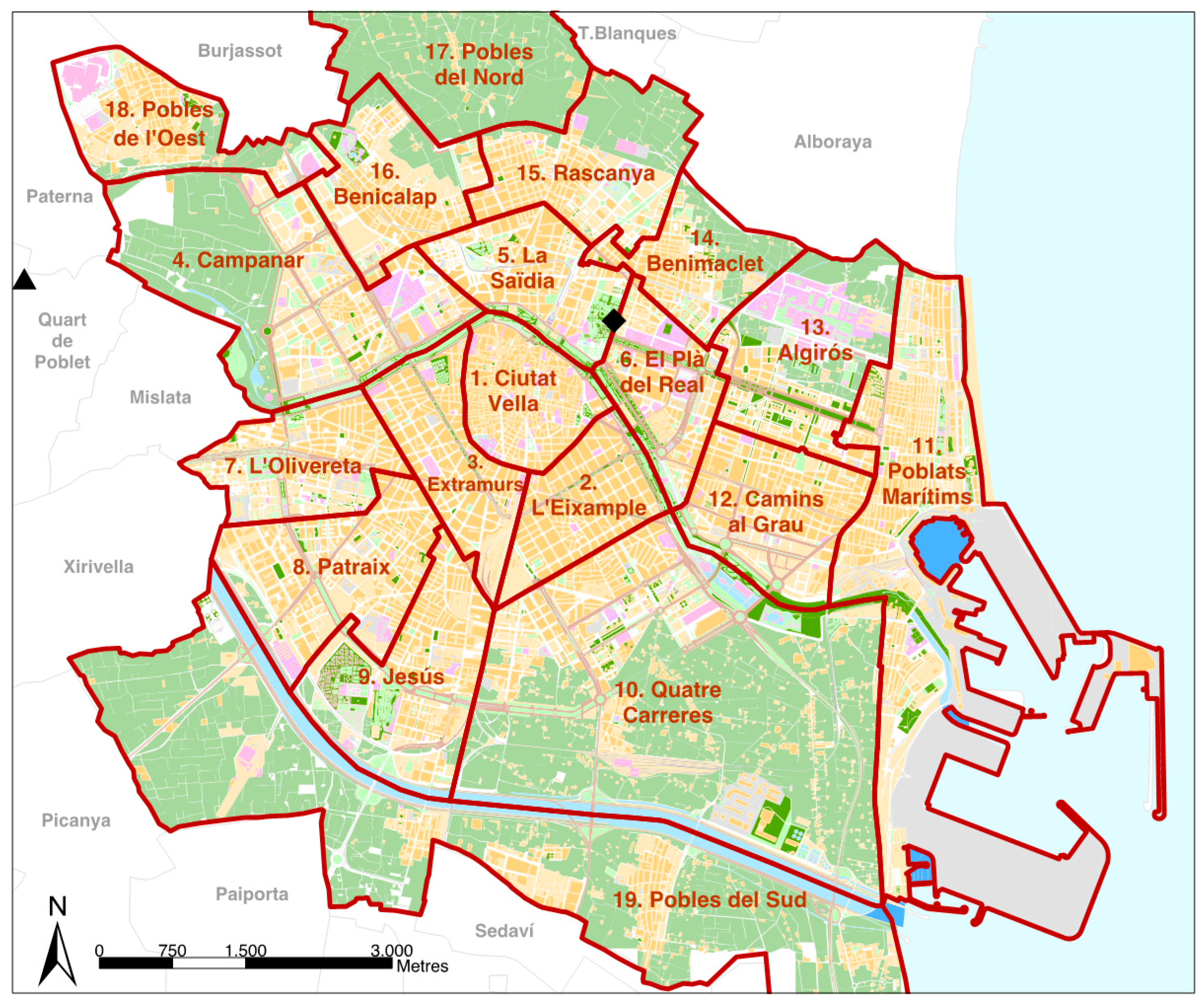

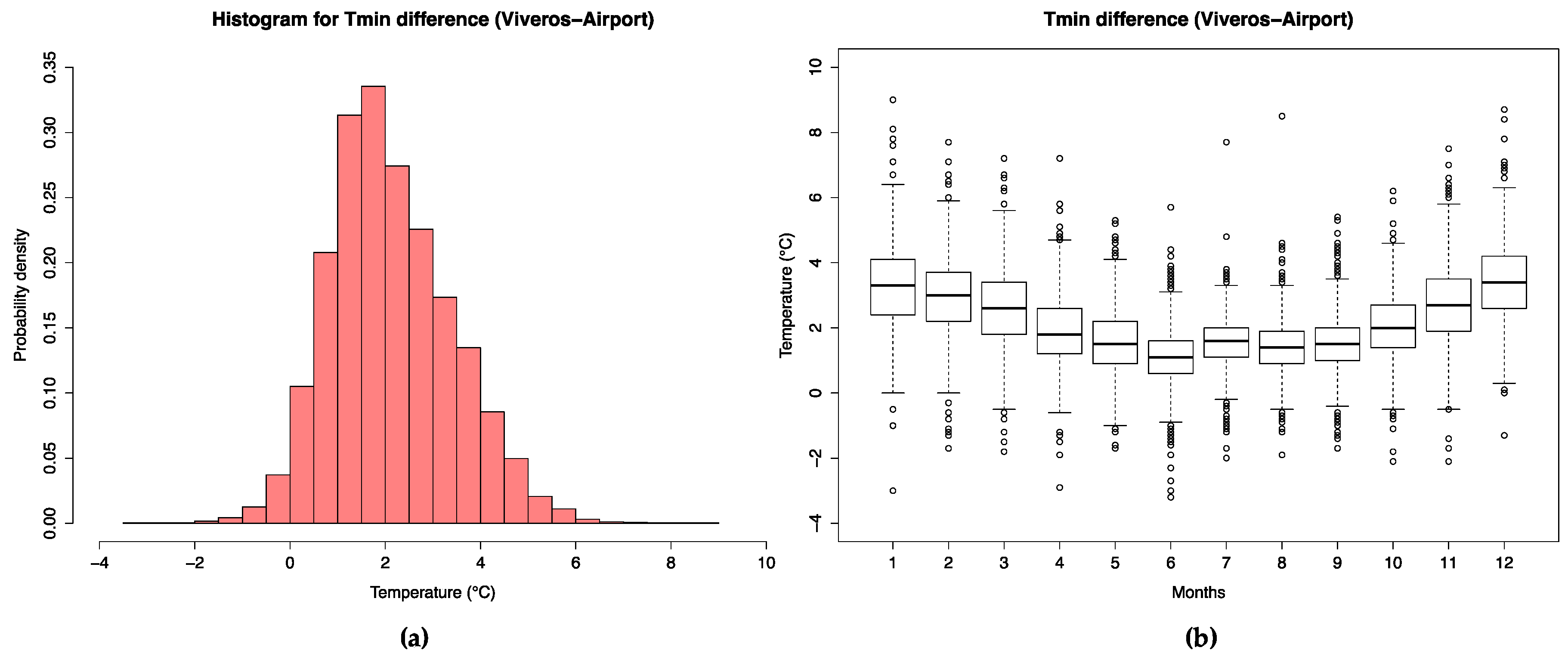
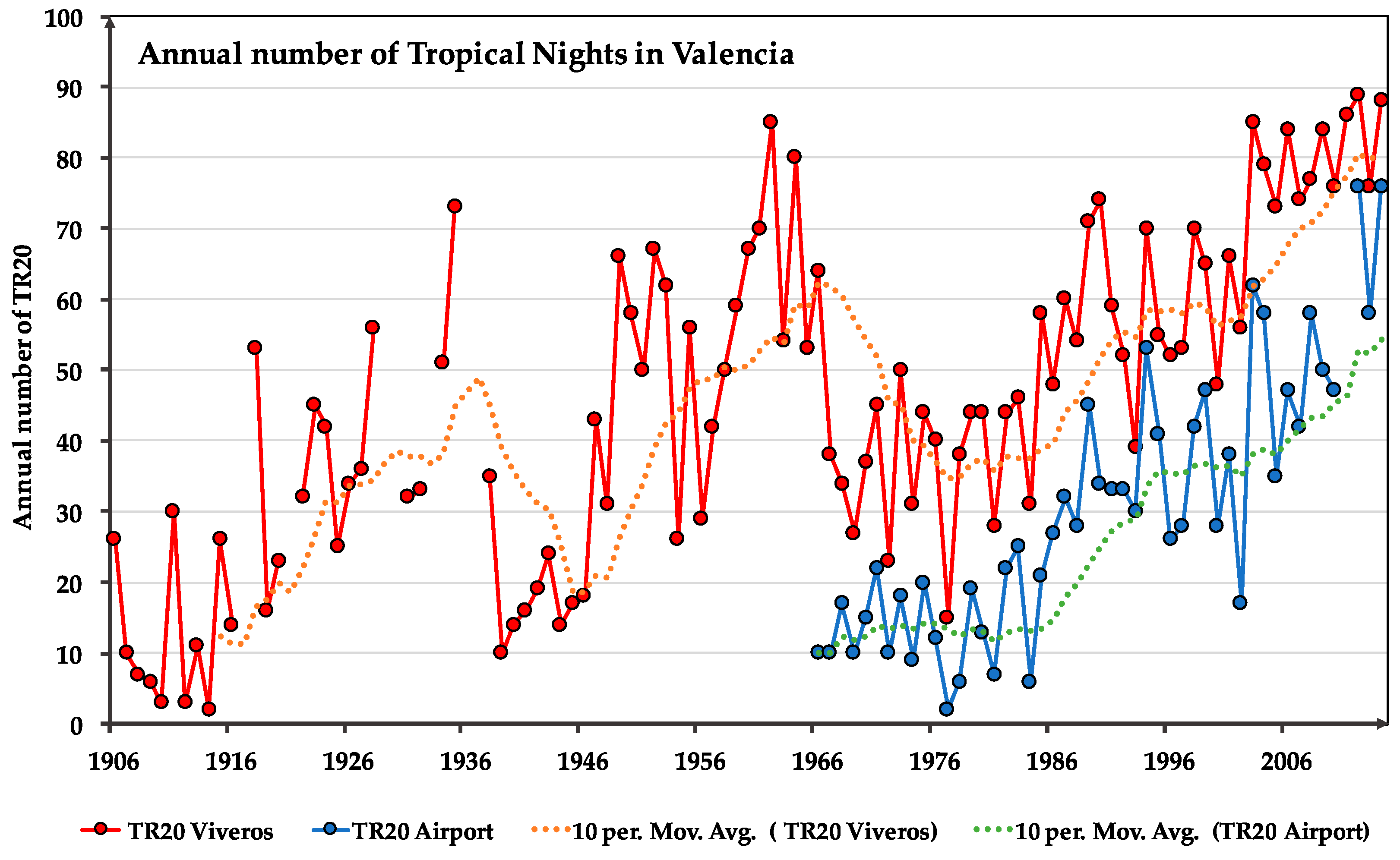
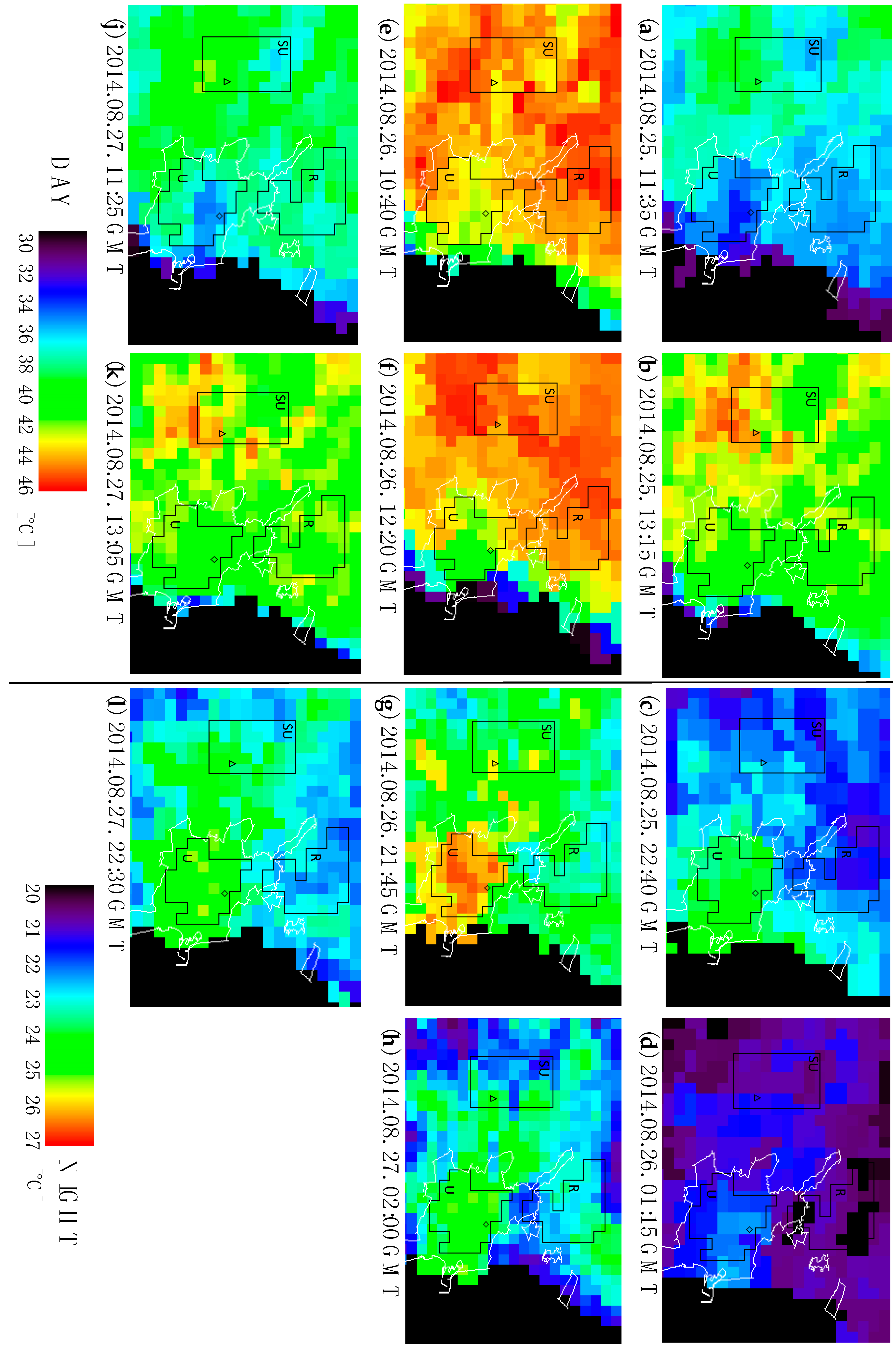
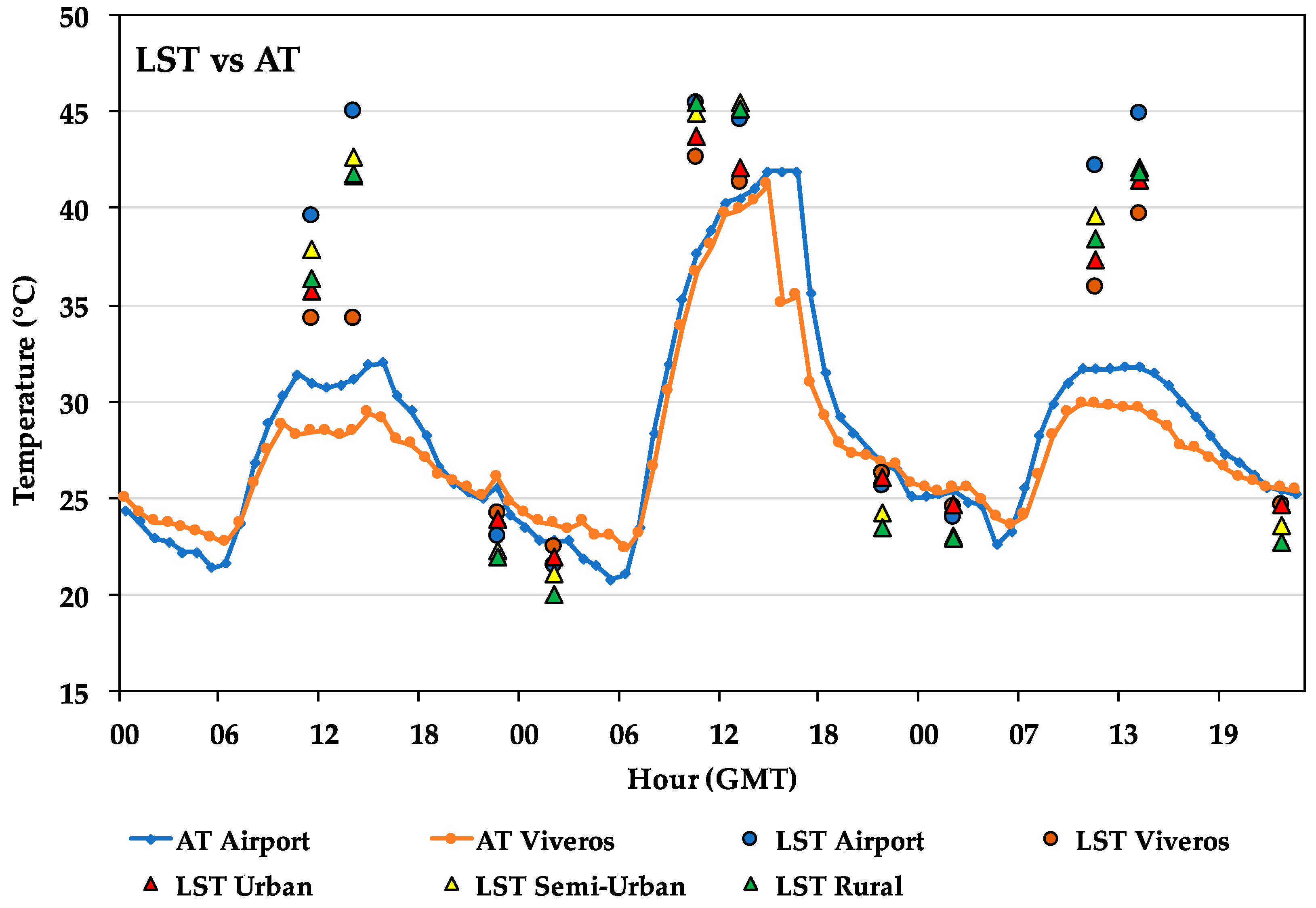
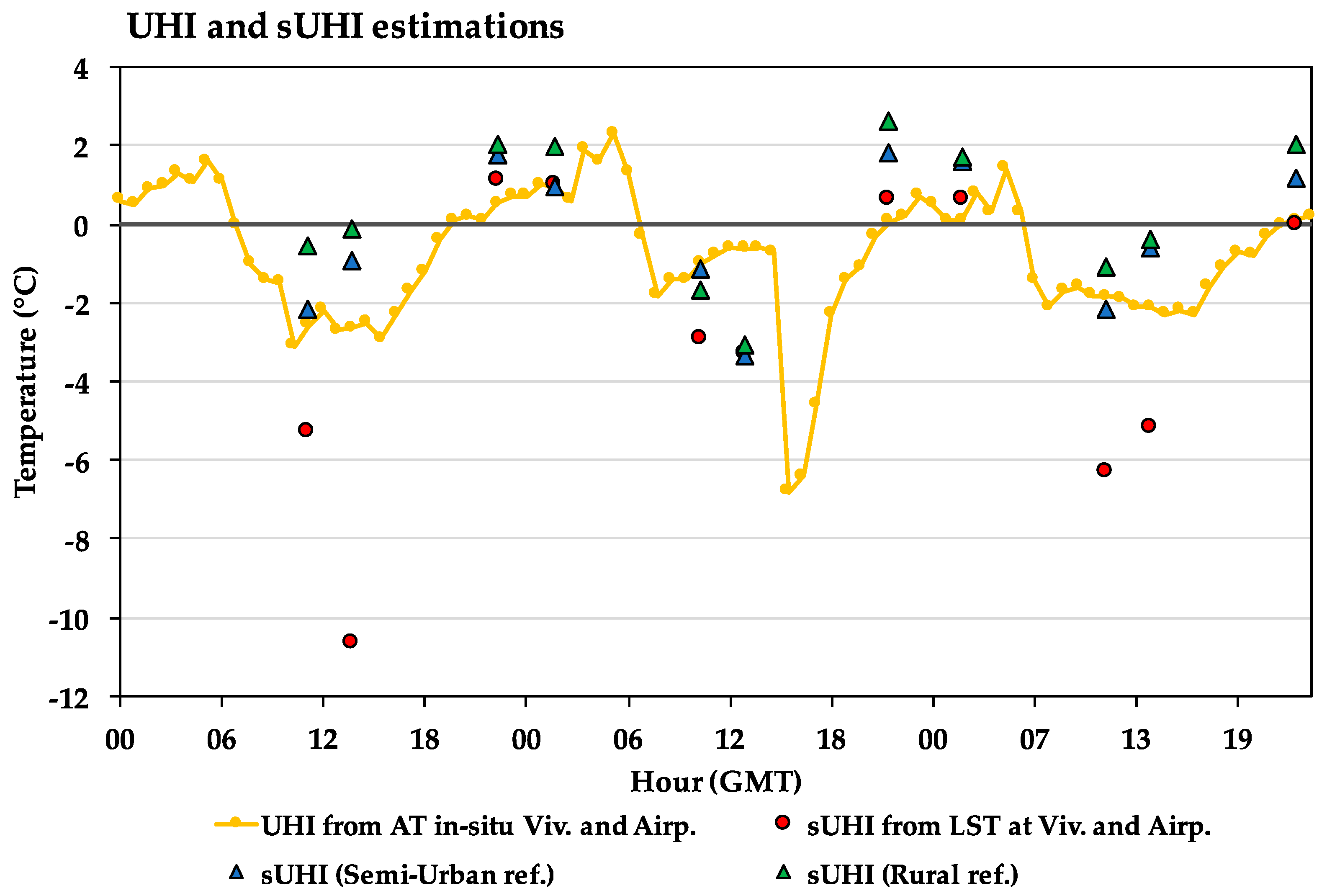
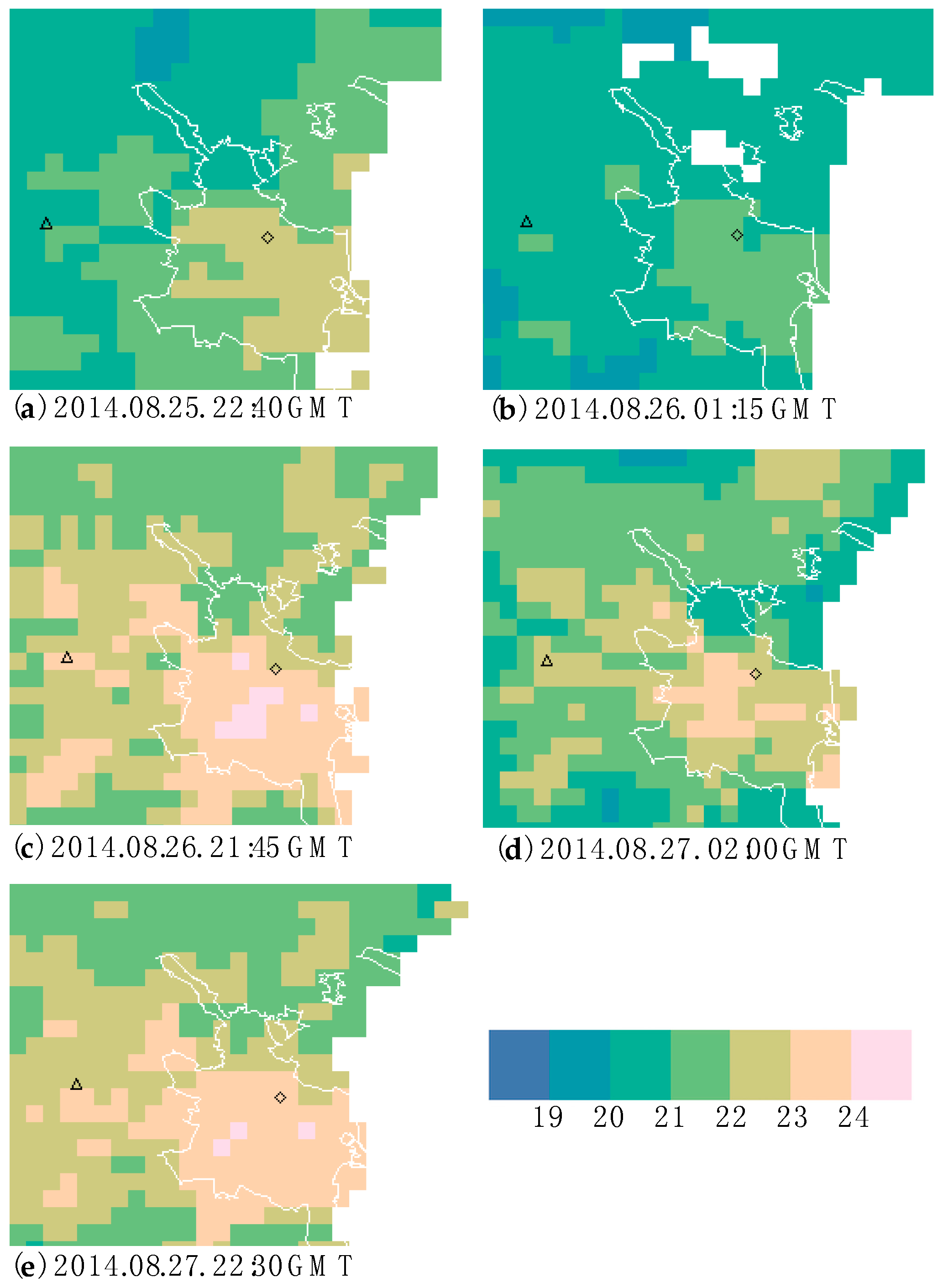
| Date | ATv (°C) min/max | ATa (°C) min/max | RHa (%) min/max | Solar Time (GMT) | Wind Directiona | Wind Speeda (km h−1) | Description |
|---|---|---|---|---|---|---|---|
| 25 August | 22.7/30.2 | 21.1/32.4 | 32/88 | 0–5 6–8 9–16 17–20 21–24 | NW-W Calm SE–E NE-E variable | 2–5 0 4–19 15–21 0–5 | light air calm gentle breeze mild/gentle breeze calm/light air |
| 26 August | 22.2/41.6 | 20.5/42.2 | 8/90 | 0–10 11–16 17–20 21–24 | v.a. W SW NE-E variable | 2–6 21–33 8–20 0–8 | light air mild breeze gentle breeze calm/light breeze |
| 27 August | 23.1/30.5 | 22.6/32.4 | 41/87 | 0–4 5–8 9–18 19–24 | E variable E SE | 6–9 3–9 8–22 2–6 | light breeze light air mild/gentle breeze light air |
| Image Acquisition Time (GMT) | View Zenith Angle (°) 1 | Pixel Size (km) | Urban (°C) | Semi-Urban (°C) | Rural (°C) | sUHI Ref.: SU (°C) | sUHI Ref.: R (°C) |
|---|---|---|---|---|---|---|---|
| 25 August 2014. 11:35 (a) | 54 | 2.7 | 35.8 | 37.9 | 36.3 | −2.2 | −0.6 |
| 25 August 2014. 13:15 (b) | 14 | 1.0 | 41.7 | 42.6 | 41.8 | −0.9 | −0.1 |
| 25 August 2014. 22:40 (c) | 53 | 2.7 | 23.9 | 22.2 | 21.9 | 1.7 | 2.0 |
| 26 August 2014. 01:15 (d) | 61 | 3.6 | 22.0 | 21.0 | 20.9 | 0.9 | 2.0 |
| 26 August 2014. 10:40 (e) | 28 | 1.2 | 43.8 | 44.9 | 45.5 | −1.1 | −1.7 |
| 26 August 2014. 12:20 (f) | 61 | 3.6 | 42.0 | 45.4 | 45.2 | −3.3 | −3.1 |
| 26 August 2014. 21:45 (g) | 30 | 1.3 | 26.1 | 24.3 | 23.5 | 1.8 | 2.6 |
| 27 August 2014. 02:00 (h) | 7 | 1.0 | 24.6 | 23.1 | 22.9 | 1.6 | 1.7 |
| 27 August 2014. 11:25 (j) | 42 | 1.7 | 37.4 | 39.6 | 38.5 | −2.2 | −1.1 |
| 27 August 2014. 13:05 (k) | 12 | 1.0 | 41.5 | 42.1 | 41.9 | −0.6 | −0.4 |
| 27 August 2014. 22:30 (l) | 41 | 1.7 | 24.7 | 23.6 | 22.7 | 1.2 | 2.0 |
| DI Category | DI Temperature (°C) |
|---|---|
| Hyperglacial | <−40 |
| Glacial | −39.9 to −20 |
| Extremely cold | −19.9 to −10 |
| Very cold | −9.9 to −1.8 |
| Cold | −1.7 to 12.9 |
| Cool | 13–14.9 |
| Comfortable | 15–19.9 |
| Hot | 20–26.4 |
| Very hot | 26.5–29.9 |
| Torrid | >30 |
© 2017 by the authors; licensee MDPI, Basel, Switzerland. This article is an open access article distributed under the terms and conditions of the Creative Commons Attribution (CC BY) license (http://creativecommons.org/licenses/by/4.0/).
Share and Cite
Lehoczky, A.; Sobrino, J.A.; Skoković, D.; Aguilar, E. The Urban Heat Island Effect in the City of Valencia: A Case Study for Hot Summer Days. Urban Sci. 2017, 1, 9. https://doi.org/10.3390/urbansci1010009
Lehoczky A, Sobrino JA, Skoković D, Aguilar E. The Urban Heat Island Effect in the City of Valencia: A Case Study for Hot Summer Days. Urban Science. 2017; 1(1):9. https://doi.org/10.3390/urbansci1010009
Chicago/Turabian StyleLehoczky, Annamária, José A. Sobrino, Dražen Skoković, and Enric Aguilar. 2017. "The Urban Heat Island Effect in the City of Valencia: A Case Study for Hot Summer Days" Urban Science 1, no. 1: 9. https://doi.org/10.3390/urbansci1010009
APA StyleLehoczky, A., Sobrino, J. A., Skoković, D., & Aguilar, E. (2017). The Urban Heat Island Effect in the City of Valencia: A Case Study for Hot Summer Days. Urban Science, 1(1), 9. https://doi.org/10.3390/urbansci1010009







